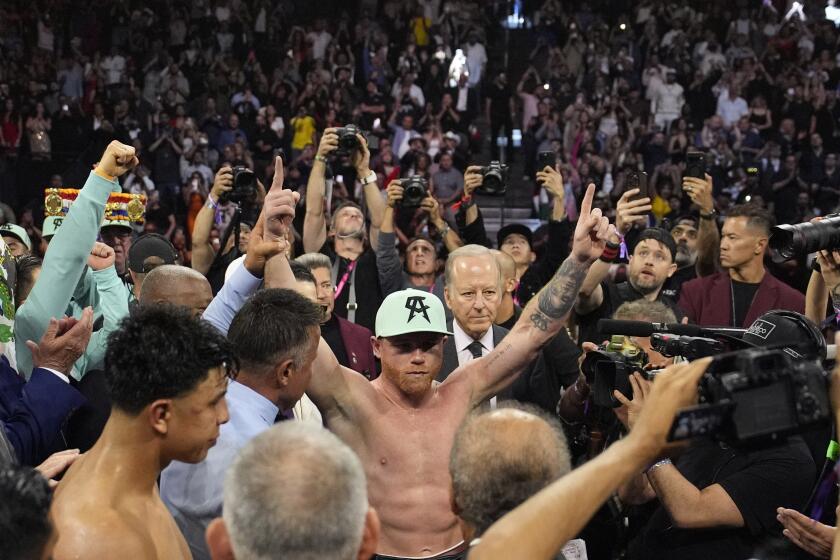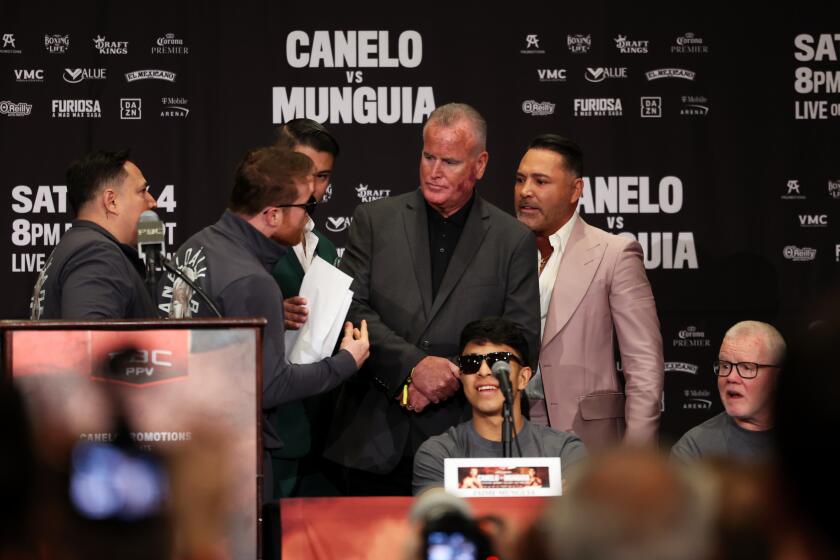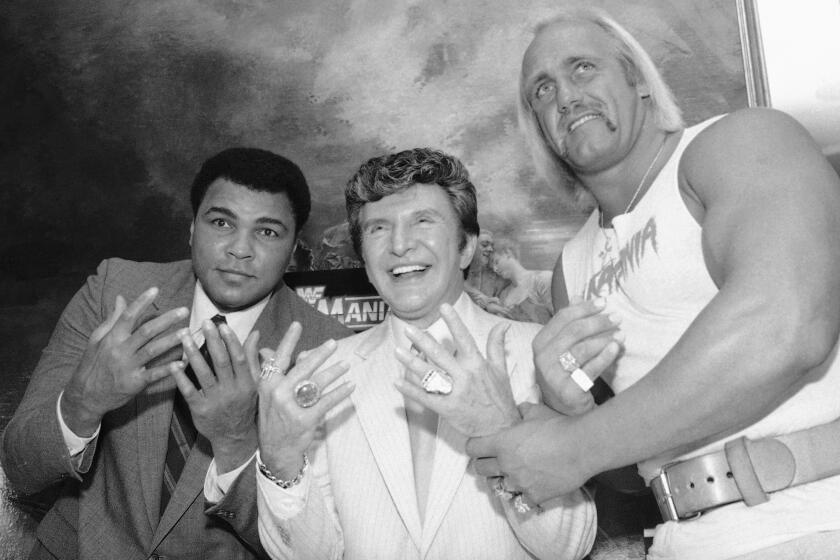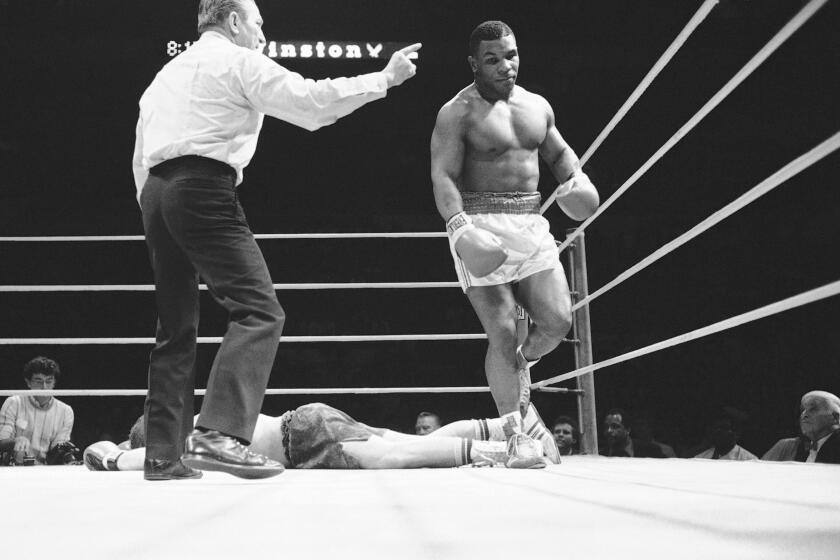Guard Is Down for Major Injuries : Boxing: Insurance coverage usually proves inadequate when fighters have to be hospitalized.
Picture this: Michael Jordan drives through the lane in the NBA playoffs and takes a vicious, though unintentional, blow to the head from Charles Barkley’s elbow.
Jordan is knocked to the floor. Teammates and trainers gather around him. Jordan rises to his feet, walks slowly off the court . . . and finds he has clouded vision.
He is taken to the locker room and then to a hospital, where doctors discover he has suffered retinal injuries to both eyes.
Now try to picture this: A year after the accident, with Jordan still undergoing expensive treatment to regain his sight, NBA teams hold benefit games for him to help him pay for his medical bills.
And that is impossible to imagine, right?
The NBA won’t release its insurance data, but it’s safe to say its players are covered by a policy that would pay hundreds of thousands of dollars in medical costs.
The same is true of most major American sports. Nearly all athletes are covered by some form of adequate medical insurance.
All except boxing.
Six months ago at the Forum, boxer Johnny Chavez of Azusa suddenly lost sight of his opponent in the sixth round of an eight-round bout.
While being driven home that night, he discovered he had lost all sight in one eye and had little left in the other.
Johnny Chavez, six months later, owes $67,000 in medical bills and the amount is climbing. He faces years of medical treatment with no guarantee that his vision will be normal again.
The insurance policy that covered him that night was good for $20,000, the minimum required by California law.
Professional boxing is an activity supposedly regulated by the state. But as a practical matter, professional boxing, in every state and in every country, is virtually ungoverned.
Boxing’s regulators have known for decades that insurance requirements were inadequate. Yet every time a boxer suffers a major injury and is left with only the pain and the medical bills, those who govern the sport continue to do largely the same--nothing.
Said boxing manager Lou Falcigno: “A policy covering you for $20,000 might have been a good one in the 1940s, but in the 1990s? That’s a joke.”
This is what the writer Jimmy Cannon meant years ago when he called boxing “the red light district of sports.”
Last March, Falcigno’s Russian featherweight, Sergei Artemiev, was boxing in Atlantic City. For four rounds, he was winning easily over Carl Griffith.
Beginning in round five, Artemiev “began to look sluggish,” Falcigno said.
“By the 10th round, I knew something was wrong with the kid,” Falcigno said. “Sergei got a bad cut in the 10th and the referee stopped it. But when Sergei sat down on his stool, his eyes started rolling. We laid him down on the floor and they took him out on a stretcher, to a hospital.”
Artemiev had a blood clot on his brain.
That was 13 months ago. Artemiev is still in rehabilitation and therapy. He can walk, he can laugh and he can talk.
“But it doesn’t take long when you’re with him to tell that Sergei still has a long way to go,” Falcigno said.
He also has $38,000 in hospital bills and rehabilitation costs are up to $60,000.
His insurance?
“Sergei was covered for $20,000,” Falcigno said.
“The insurance system in boxing covers the wrong things. On a homeowner’s policy, you don’t buy coverage for a tree limb breaking a window. You get coverage for the tree destroying your house.
“These policies are covering little stuff like a lost tooth or a broken hand. They totally ignore the catastrophic injury aspect.”
How much boxer insurance coverage is required?
“I don’t know what it is,” said Larry Hazzard, executive officer of the New Jersey Athletic Commission.
“It’s between $10,000 and $20,000, something like that. We need to take a long look at our insurance coverage.”
The California Athletic Commission requires only $20,000 in insurance coverage.
Said Joe Sayatovich, the San Diego manager of junior-middleweight champion Terry Norris:
“A Mexican kid named Rogelio Perez came to me, wanted me to handle him. We worked him in the gym, then got him on a card at Laughlin, Nev., about six weeks ago,” Sayatovich said.
“I hadn’t signed him. I wanted to see him in a bout first. He lost an eight-round bout. He slumped on his stool afterward, and the ringside doctor ordered a helicopter to get him to a Las Vegas hospital.
“He’d had an aneurysm, but it stopped bleeding on its own. He’s still undergoing treatment. His medical bills are up to about $18,000. I’ll wind up paying for a lot of it.
“But the point is, how in hell can you allow promoters to put these kids in the ring and cover them for a maximum of $20,000?
“That’s the same as telling them: ‘No, we are not going to insure you for serious injury.’ ”
Dr. Elias Ghanem, chairman of the Nevada Athletic Commission, said that only recently did his state increase promoters’ insurance coverage from $5,000 to $20,000. Now, he said, there is a bill in the Nevada legislature to increase it to $50,000.
“Also, we’re looking at creating an umbrella policy that covers every boxer for catastrophic injuries, in addition to a basic $50,000 promoter’s policy,” Ghanem said.
“We think four-round fighters should be just as protected as champions.”
Other Nevada and California boxing regulators said their commissions might study the concept of boxers themselves, managers and promoters sharing the cost of increased coverage.
Dan Goossen, Van Nuys-based manager of junior-lightweight Gabe Ruelas, recounted recently the broken elbow his boxer suffered in a 1990 Las Vegas bout with Jeff Franklin.
At the time, Nevada required only a $10,000 policy covering boxers. Ruelas required two operations and was out of boxing for a year, undergoing rehabilitation.
“The whole thing cost Gabe $24,000 and he still owes about $8,000,” Goossen said.
Goossen, who is also a promoter, says to cover each boxer on a five-bout card for $20,000 costs about $1,200.
More to Read
Get our high school sports newsletter
Prep Rally is devoted to the SoCal high school sports experience, bringing you scores, stories and a behind-the-scenes look at what makes prep sports so popular.
You may occasionally receive promotional content from the Los Angeles Times.






